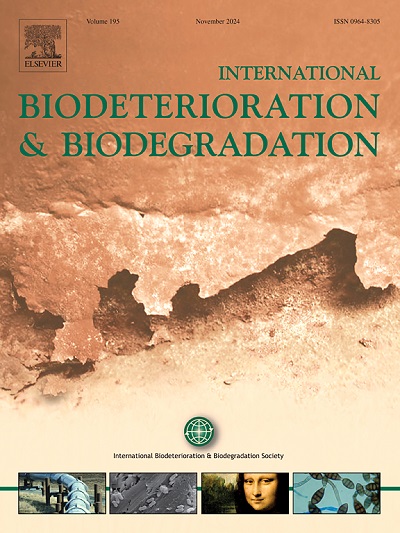New insights in the metabolic functions of freshwater sulfate reducing communities during steel corrosion by biophysicochemical, 16S rRNA gene sequence and metaproteomic analysis
IF 4.1
2区 环境科学与生态学
Q2 BIOTECHNOLOGY & APPLIED MICROBIOLOGY
International Biodeterioration & Biodegradation
Pub Date : 2025-02-01
DOI:10.1016/j.ibiod.2024.105995
引用次数: 0
Abstract
To date, the focus of microbially induced corrosion (MIC) studies has largely been on marine environments. In this study, biocorrosion of steel enrichment cultures from a freshwater corrosion site was investigated under sulfate reducing conditions. Biomass and metabolic processes were monitored by measuring the time-dependent biophysicochemical parameters and with Fe0 (steel) as the sole electron source, or with H2 as control. Although yields and sulfate reduction rates were higher with H2 due to its greater bioavailability, the yield coefficients indicated that bacterial growth with Fe0 was equally efficient. Upon imaging of the steel surface by SEM, patches of cells embedded in an iron sulfide matrix on top of larger carbonate and phosphate minerals were observed. Cell number determination indicated that the cells on the steel surface constituted only a minor proportion (<4%) of the total counts. The 16S rRNA gene sequencing revealed the enrichment of sulfate reducers next to acetogens, indicating a syntrophic relationship. In compliance with biophysicochemical analysis and estimated yield coefficients, metaproteomics indicated no major differences in the pathways of energy metabolism between treatments with H2 and Fe0. Highly abundant proteins namely periplasmic hydrogenases and c-cytochromes associated with H2-mediated electron transfer coupled to dissimilatory sulfate reduction indicated this mechanism to be dominant (except for a few putative outer membrane proteins identified with Fe0). In conclusion, using a multiphasic approach including metaproteomics to elucidate metabolic pathways improved the overall understanding of microbial processes associated with freshwater MIC.

基于生物物理化学、16S rRNA基因序列和元蛋白质组学分析的淡水硫酸盐还原群落在钢腐蚀过程中的代谢功能新见解
迄今为止,微生物诱导腐蚀(MIC)研究的重点主要集中在海洋环境上。在本研究中,研究了硫酸盐还原条件下淡水腐蚀现场富钢培养物的生物腐蚀。通过测量随时间变化的生物物理化学参数,以Fe0(钢)为唯一电子源,或以H2为对照,监测生物量和代谢过程。虽然H2的产率和硫酸盐还原率较高,因为它的生物利用度更高,但产率系数表明,在Fe0下细菌生长同样有效。通过扫描电镜对钢表面进行成像,可以观察到嵌入在较大的碳酸盐和磷酸盐矿物顶部的硫化铁基质中的细胞斑块。胞数测定表明,钢表面的胞数只占总数的很小比例(<4%)。16S rRNA基因测序结果显示,硫酸盐还原剂富集在乙酸旁边,表明其具有共生关系。根据生物理化分析和产量系数估算,宏蛋白质组学在H2和Fe0处理之间的能量代谢途径没有明显差异。大量的蛋白质,即与h2介导的电子转移相关的质周氢化酶和c-细胞色素,与异化硫酸盐还原相结合,表明这种机制是主要的(除了少数推测的与Fe0鉴定的外膜蛋白)。总之,使用包括宏蛋白质组学在内的多相方法来阐明代谢途径,可以提高对与淡水MIC相关的微生物过程的整体理解。
本文章由计算机程序翻译,如有差异,请以英文原文为准。
求助全文
约1分钟内获得全文
求助全文
来源期刊
CiteScore
9.60
自引率
10.40%
发文量
107
审稿时长
21 days
期刊介绍:
International Biodeterioration and Biodegradation publishes original research papers and reviews on the biological causes of deterioration or degradation.

 求助内容:
求助内容: 应助结果提醒方式:
应助结果提醒方式:


